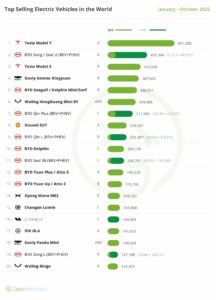The growing need for zero-emission commercial vehicles
Road transport emissions reached a staggering 6,3 gigatons of CO2 in 2023, with commercial vehicles expected to become the largest contributor to these emissions by 2040. As more governments push for cleaner technologies, the market for zero-emission commercial vehicles—especially medium- and heavy-duty trucks—is expanding rapidly. This shift is driven by improvements in battery technology, government incentives, and the growing availability of charging stations.
According to BNEF, sales of zero-emission trucks surged in the first half of 2024, reaching 38.000 units globally. China led the way, accounting for over 80% of these sales. Meanwhile, Europe is showing steady progress, though adoption in the U.S. lags behind. Despite these gains, the uptake of ZEVs varies significantly from country to country, underscoring the importance of scaling up charging infrastructure to support wider adoption.
The crucial role of charging infrastructure
Charging infrastructure is critical to the mass adoption of electric commercial vehicles. The BNEF report estimates that nearly 600.000 public chargers were installed globally during the first half of 2024, bringing the total to 4,5 million. China continues to dominate this space, housing 70% of the world’s charging stations. Europe is also seeing rapid growth, particularly in ultra-fast chargers, which have increased sevenfold since 2021.
In contrast, the U.S. has been slower to expand its charging network. However, federal programs like the National Electric Vehicle Infrastructure (NEVI) program are beginning to make a difference. Billions of dollars are being funnelled into EV infrastructure, including plans to build charging corridors along key freight routes. This development is crucial for the electrification of heavy-duty vehicles, which require more advanced and powerful charging stations compared to smaller passenger vehicles.
Charging companies raise nearly $14 billion
The report highlights that since early 2022, charging companies have raised almost $14 billion, with more than $3 billion secured in the first half of 2024 alone. These investments are spread across acquisitions, venture capital, and private equity deals, reflecting the broad interest in the EV charging sector. Countries like the U.S. and U.K. have seen a particularly high level of activity, with each country leading in the number of deals closed.
One notable example is California-based Terawatt, which raised $1 billion in 2022 to build truck charging stations along major U.S. freight corridors. Another key player, WattEV, also based in California, raised significant capital in 2023 to expand its leasing services for electric trucks and charging infrastructure. The broad range of business models and geographic focus areas demonstrate the varied and growing opportunities in the EV charging space.
Addressing the challenges of charging infrastructure
While the growth in charging infrastructure is encouraging, challenges remain. Heavy-duty vehicles, like trucks, require high-power charging solutions that can be expensive and complex to install. Moreover, the geographic spread of charging stations is uneven, with rural areas and emerging markets still lacking sufficient infrastructure.
The report also highlights some innovative approaches being developed to overcome these obstacles. In China, for example, battery swapping technology is gaining traction. This allows commercial vehicles to quickly replace depleted batteries with fully charged ones, reducing downtime significantly. Currently, China operates more than 600 battery-swapping stations for trucks, spearheaded by companies like Qiyuan Green Power, a subsidiary of the State Power Investment Corporation (SPIC).
As battery costs continue to decline and vehicle ranges improve, electric trucks are becoming more cost-competitive with their diesel counterparts. BNEF projects that electric trucks could reach total cost of ownership (TCO) parity with diesel vehicles by the end of this decade, particularly for short- and medium-haul routes.
The role of government policies in driving growth
Government support is key to accelerating the deployment of charging infrastructure. In Europe, strict emissions standards are driving manufacturers to ramp up zero-emission truck production, while the European Union is working to expand public charging networks through regulations like the Alternative Fuels Infrastructure Regulation.
In the U.S., state-level policies, particularly in California, have been instrumental in pushing ZEV adoption. California’s sales mandates for zero-emission trucks will require between 5% and 9% of new medium- and heavy-duty truck sales to be zero-emission by 2024. These mandates are driving demand for charging infrastructure, as fleets prepare to comply with these regulations.
Looking ahead: The future of EV Charging infrastructure
The $14 billion raised by charging companies since 2022 marks a pivotal moment in the transition to zero-emission transportation. As more countries set ambitious carbon reduction goals, the demand for reliable and widespread charging infrastructure will only grow. While challenges persist, particularly in scaling up infrastructure and ensuring equitable access, innovative solutions and strong government support are helping to accelerate the transition.
With advancements in battery technology and a steady flow of investment into the EV charging sector, the future of zero-emission commercial vehicles looks promising. As infrastructure continues to expand and costs decline, the industry is well-positioned to make significant strides in reducing global carbon emissions and moving closer to net-zero targets.
Source: BloombergNEF







